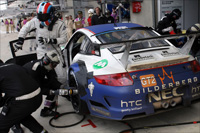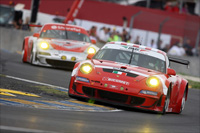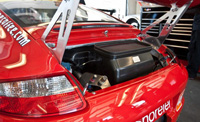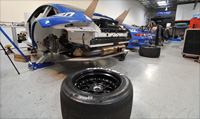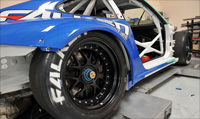99 | 00 | 01 | 02 | 03 | 04 | 05 | 06 | 07 | 08 | 09 | 10
2010 GT3 RSR specfications
Concept
Porsche 911 GT3 RSR
single-seated GT race vehicle.
in accordance with the current A.C.O. LMGT2 Regulations and the FIA Article
257 (Technical Regulations for Series Grand Touring Cars).
basis: Porsche 911 GT3 RS (997; street legal version), homologated from January
2010 onwards.
Engine
Water-cooled, six-cylinder boxer
engine; four-valves per cylinder.
3,996 cc; stroke 80.4 mm; bore 102.7 mm
331 kW (450 hp) at 7,800 rpm
max torque 430 Nm at 7,250 rpm
max revs 9,400 rpm
dry sump lubrication
individual throttle butterflies
fuel injection
air restrictors 2 x 28,6 mm.
Power Train
Six-speed gearbox with sequential jaw-type shift
oil/water heat exchanger
single-mass flywheel
hydraulic disengagement lever
three-plate carbon-fibre clutch
limited slip differential 45/65%
rear-wheel drive
Bodywork
Monocoque body (basis 911 GT3 RS) of hot-galvanised steel; aerodynamiccally optimised front end with front spoiler; aerodynamically optimised front underfloor; adjustable rear wing; 90-litre safety fuel tank with fast filling function; air jack; welded-in safety cage; bucket-type racing seat (driverís side only) with flame retardant seat cover; six-point seat belt adapted for use of the HANS Head and Neck Support; electric fire extinguishing system.
Vehicle Weight
approx. 1,220 kg complying with
A.C.O. regulations,
approx. 1,245 kg complying with FIA regulations.
Suspension
Front axle:
McPherson spring strut axle; Sachs four-way gas pressure dampers; double coil
springs (main and auxiliary spring); front axle arms adjustable for camber;
adjustable sword-type anti-roll bar on both sides; power steering.
Rear:
Multi-arm axle with rigidly mounted axle sub-frame; Sachs four-way gas pressure
dampers; double coil springs (main and auxiliary spring); rear axle tie-bar
reinforced and infinitely adjustable; adjustable sword-type anti-roll bar
on both sides. Complete suspension infinitely adjustable (height, camber,
track).
Rims/Tires
Front: Three-piece BBS light-alloy wheels (11J x 18-34); central bolt.
Rear: Three-piece BBS light-alloy wheels (13J x 18-12.5); central bolt.
Brake System
Brake system with balance bar control.
Front: Single-piece six-piston aluminium fixed callipers; inner-vented, 380 mm in diameter; racing brake pads.
Rear: Single-piece four-piston aluminium fixed callipers; inner-vented, 355 mm in diameter; racing brake pads..
Electrics
Motec display with integrated data recording; multi-function display with
integrated gearshift indicator; adjustable traction control; battery:
12 volt, 50 Ah, 140 Ah alternator.
A Decades Perspective
The 911 GT3 RSR is the most successful GT racer in the world.
Once again, the Porsche 911 GT3 RSR is the world's most successful GT race
car. The fastest racing-911, developed following the rules of the GT2 category
and based on the principles of Porsche Intelligent Performance, left its mark
on race tracks around the globe with good lap times, excellent reliability
and particularly low fuel consumption. Powered by a 450 hp four-litre six-cylinder
boxer engine, the vehicle triumphed in the GT2 category in 2010 at the Le
Mans 24 hour race, won championships in the Le Mans Series and the American
Le Mans Series and claimed overall victories at the 24 hour races in Dubai
and Spa-Francorchamps. It won against strong competitors including Ferrari,
BMW, Aston Martin.
The Porsche 911 GT3 RSR, based on the road-legal 911 GT3 RS, not only impressed
with race wins. In the American Le Mans Series, it was once again the GT vehicle
with the best overall efficiency in the ratio of lap times and fuel consumption.
For this, the vehicle was the overall winner of the environmental Michelin
Green X Challenge for the second time in succession. And at the Le Mans 24
Hours, the RSR also won the Green X Challenge. "It's giving the right
signal to place more importance on the efficiency of a racing car" says
Hartmut Kristen, Head of Porsche Motorsport. "Winning the Green X Challenge,
which is a very important success for us, proves that the Porsche 911 is not
only fast, but also very economical."
.In its current form, the Porsche 911 GT3 RSR of the 997 type has been sold
to international customers since 2007. From year to year, the top model of
911 racing vehicles received ongoing modifications. The most conspicuous changes
were made to the 2009-model. The capacity of the six-cylinder boxer engine
at the rear grew from 3.8 to 4.0-litres, resulting in an optimised torque
curve at reduced revs as well as better driveability. The most distinguishing
feature of the still current 911 GT3 RSR is the redesigned front section with
a large ventilation opening. Noticeable at first sight are the air outlet
slots, the so-called louvers, on the front hood. They are an indication of
the completely revamped air ducting of the radiators, which became necessary
through the new design of supply and discharge air with the installation of
an optional air-conditioning unit. The aerodynamics under the rear underwent
further optimisation. The rear wing now features a wider adjustment range.
Compared to the 2008-model, the weight-optimised brake system and the lighter
wiring harness contribute to further improved driving dynamics.
A great deal of know-how from the successful RS Spyder sports prototype went
into the gearbox of the 911 GT3 RSR. The sequential six-speed gearbox developed
by Porsche engineers is considerably lighter than the unit fitted in the predecessor
and has much less internal friction. The flatter angle to the drive shafts
allow teams greater scope for the suspension set-up.
The foundation for today's successes was already laid with the racing variants
of the Porsche 911 996 type. Built to contest the GT class of the Le Mans
24 Hours, the 911 GT3 R clinched virtually all GT class wins in the 1999 American
Le Mans Series. In 2001, the modified 911 GT3 RS version was raced. This vehicle
was not just successful in its class, but also celebrated prestigious overall
wins, with the two German Porsche works drivers Joerg Bergmeister and Timo
Bernhard an team owner Kevin Buckler beating significantly more powerful prototypes
at the Daytona 24 hour race in 2003. Porsche factory pilot Marc Lieb (Germany)
won the 24 Hours of Spa with Romain Dumas (France) and Stephane Ortelli (Monaco)
in the same year beating all the much more powerful GT1 cars.
In the 2004 season, the successor model 911 GT3 RSR (996) made its debut.
The output of its 3.6-litre six-cylinder boxer engine increased to 455 hp
(335 kW) at 8,500 rpm, the maximum torque to 410 Nm at 7,200 rpm. By winning
the American Le Mans Series (GT class), the Le Mans Endurance Series (GT)
as well as the FIA GT Championship (N-GT), as well as class victories at the
Le Mans and Spa 24 hour races and the Petit Le Mans event, the new racing
sports car celebrated a brilliant debut season.
"It's impressive how the 911 GT3 RSR has developed from year to year.
The lap times alone are astounding, because despite the restrictions imposed
on us again and again by the regulations, the car just got faster every year,"
says Porsche works driver Joerg Bergmeister, who celebrated the majority of
his successes at the wheel of the RSR. For this reason, the five-time winner
of the American Le Mans Series is not at all anxious about tackling the 2011
season: "When you finish a season you always think: now we've reached
our limit, now the car's gone as far as it can go. And then Porsche comes
up with something new again. And I reckon it won't be any different in 2011."
Notable Victories
Winner American Le Mans Series (GT
class)
Winner Le Mans Series (GT2 class)
1st place Le Mans 24 Hours (GT2 class)
1st place Dubai 24 Hours (overall win)
1st place Spa 24 Hours (overall win)

